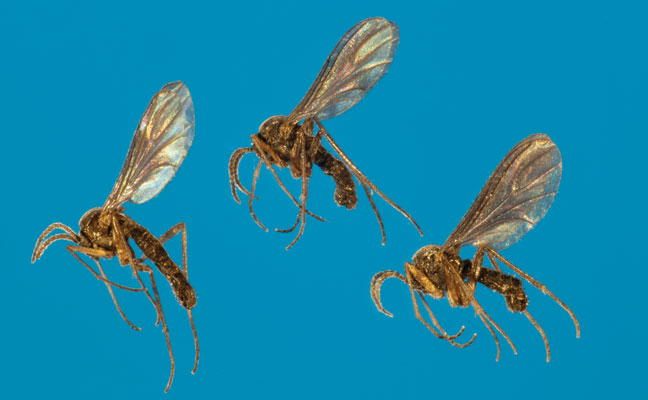
Fungus gnats, Scardarie family. Photo: courtesy of, and copyrighted by, Gene White, pmimages@earthlink.net
Question: I’m dealing with some little flies in one of my customer’s houses for which I can’t seem to find the source. I’ve spent some time looking in the places you might look in a restaurant-type property and have not found any sources, so I’m starting to think they are just gnats coming in from outside. Any thoughts on whether that might be the case?
— FLYING LITTLE INSECTS ENTERING STRUCTURES
Answer: Without additional information, FLIES, I may not be able to answer your specific question. But I’ll try to break down what might be breeding in the house.
I know you’ve heard it before, but I’m going to start with identification. With the most likely suspects in a home, it actually may be easier than you think. A 10X hand lens and the National Pest Management Association’s “Field Guide Pro” app likely will be able to get your identification quickly.
FUNGUS GNATS
With the 10x hand lens (those of you with good eyesight may not even need a hand lens), you can see the smoky-colored aspect of the wings of the most common fungus gnat I have seen. But there also are patterned wings out there in other fungus gnat species, which are a wide range of species in the families Mycetophilidae and Sciaridae. Both of these features are different than the other species I’m going to mention below. The app will help you out with some further details on identifying these guys, but the first thing I look for is the color of the wings.
Source focus: Potted plants are the most common place to find fungus gnats. People like to water their plants, and my guess is they water every day, even though they only need to do so once a week. Having said that, I have found fungus gnats in areas where soil was collecting in the basement due to a leak. I also have heard of issues on flat roofs allowing wet debris to build up. This can allow fungus growth, which provides food for the fungus gnats. There can be a dank, yeast-type odor associated with their habitat.
RED-EYED FRUIT FLIES

Judy Black
Not to be too simplistic, but the red eyes of Drosophila melanogaster really can be seen with a hand lens.
Source focus: Fruit, of course, but don’t forget about the bags of onions or potatoes that might be in the pantry. This is also when you should ask whether any family members may have left some old food in their bedrooms or other areas of the house. (I’m sure you never did that when you were a kid, right?) As with fungus gnats, there can be a fermentation odor associated with the habitat of
red-eyed fruit flies.
MOTH FLIES
Psychodidae — also known as drain flies, sink flies, filter flies, sewer flies and sewer gnats — will have a hairy appearance to their wings.
Source focus: Moth flies need a very wet habitat, so check floor drains, condensate pans and anywhere there is standing water. There can be a mossy, algae-type odor associated with their habitat.
For all three types of flies, control consists of eliminating the source, with possibly some knockdown for any adults that are present. With moth flies, some cleaning also will be needed in the affected areas.
Email your questions about insect identification and pest management technologies to pmpeditor@northcoastmedia.net. Your questions most likely will be printed and answered in one of Pest Management Professional’s upcoming columns.
The post Identification is key to ridding homes of flying pests appeared first on Pest Management Professional.
from Pest Management Professional https://www.mypmp.net/2022/05/04/identification-is-key-to-ridding-homes-of-flying-pests/
Sacramento CA
No comments:
Post a Comment